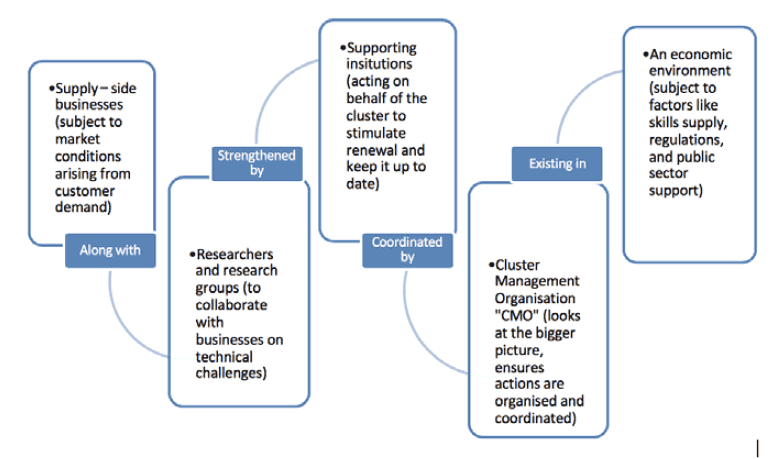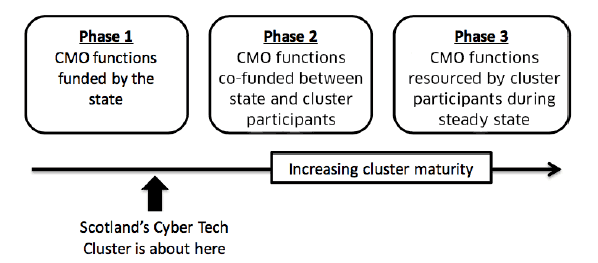Cyber resilience economic opportunity: key actions 2018-2021
The Cyber Resilience Economic Opportunity action plan sets out the key practical steps we and our partners will take to grow Scotland’s cyber security industry.
Appendix Two: Clusters and Cluster-Building
What Is a Cluster?
Clusters, essentially, are a "critical mass" of economic activity and success, based on technological, academic and business capabilities in a particular field.
The term cluster traditionally referred to geographically concentrated (or even co-located) supply-chains of businesses, researchers and associated institutions all focussing on a single market opportunity[18]. It is becoming evident that location, or co-location, is not necessarily the critical factor in cluster success. Compared to other factors, tight geographic boundaries are becoming an increasingly poor predictor of a cluster's community structure[19], and with today's ubiquitous mobility and connectivity, companies are increasingly seeking to make connections beyond those geographical boundaries.[20]
Scotland has recognised that it has the characteristics of a geographically concentrated space even when referring to activities spread across the whole of Scotland. This is enabled by our high degree of national policy coordination and aided by ever-increasing ways of communicating effectively across greater distances. A cluster could be considered an ecosystem which consists of:

The development of each of these areas – market conditions, research capability and capacity, cluster management, upgrading institutions and economic environment (including an international proposition) – is required in order for the cluster to mature and thrive.
The Cluster Development Journey
New economic opportunities are initially characterised by the appearance of businesses and researchers touching on the subject area. At first, they may not be fully occupied by the topic or may not have realised that the topic has been formalised. Government has a partial role in creating an environment under which the business and research community can emerge and coalesce. This role is most certainly secondary to the entrepreneurial drive required from businesses themselves, but is nonetheless important.
There are generally three phases to building a new cluster: (1) emergence, where the early participants cannot provide coherence within their own resources and the state usually has to fully-fund the CMO role, (2) adolescence, where the participants start to see the value of coherence and begin to find ways to contribute to CMO resourcing, and (3) maturity, whereby the participants can provide cluster coherence through a steady-state CMO supported by substantial levels of private resource.
There is a respected accreditation scheme for CMO activity in Europe[21]. The scheme is straightforward to enter and provides support as a CMO develops its capability and capacity from bronze 'label' to gold.
The emerging community of cyber security businesses and researchers in Scotland is small but is showing positive signs of healthy growth. To support emergence thus far, the Scottish government has enabled the CMO role through the provision of fully-funded Network Integrators. Recently the basis of this has changed to involve contribution in kind from the cluster itself, confirming the general view that cluster-building is coming towards the end of phase 1. The cluster has the potential as a future vehicle for the genuinely transformative collaboration that will be required to make Scotland world-class in cyber-resilience.

Contact
Email: Clare.ElAzebbi@gov.scot
There is a problem
Thanks for your feedback